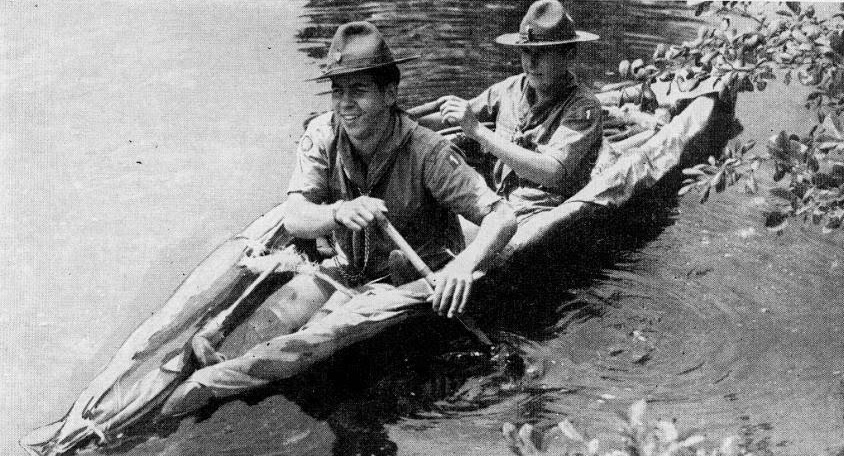 These scouts didn’t have to worry about the modern Guide to Safe Scouting, and the procurement of materials right run afoul of modern Leave No Trace principles. But these scouts 75 years ago put together this primitive canoe according to plans appearing in the November 1942 issue of Boys’ Life.
These scouts didn’t have to worry about the modern Guide to Safe Scouting, and the procurement of materials right run afoul of modern Leave No Trace principles. But these scouts 75 years ago put together this primitive canoe according to plans appearing in the November 1942 issue of Boys’ Life.
The plans given don’t go into great detail, but with a little common sense, exact instructions are not necessary. The frame of the craft is made out of several saplings, and the shell is a 12′ x 12′ tarp. The author, William “Green Bar Bill” Hillcourt, notes that “a river should be no obstacle for your Patrol if you have an axe, some string and a waterproof tarpaulin. Then you can produce a primitive canoe, and paddle yourself across, using a couple of trench shovels, pieces of bark or your hands.”
The frame is constructed by lashing the various saplings together, and then the tarp is added. It should be within the skill level of any scout who has mastered the basic lashings for First Class.
Note: In my opinion, constructing and using this canoe is a perfectly appropriate activity for modern scouts. However, proper safety precautions should be followed, and if it’s a BSA activity, then the Guide to Safe Scouting must be followed. In particular, the 1942 Scouts shown in the picture would not pass muster, since they are not wearing approved life jackets.
They are, however, following the buddy system, and I assume that they have both passed the BSA swimmer test. They’re obviously staying close to shore, and the craft appears to be seaworthy for that location.
Under current BSA rules, the “craft must be suitable for the activity, be seaworthy, and float if capsized. All craft and equipment must meet regulatory standards, be properly sized, and be in good repair.” Depending on the conditions, a boat like the one shown should qualify.
Since the boat “must meet regulatory standards,” this means that the boat must be legal under state law. In Minnesota (and probably in other states) no registration is required, since the boat is less than 10 feet in length and non-motorized.
Since constructing this boat requires cutting living trees, great care should be taken in their selection. Other materials (such as, perhaps, PVC pipe) should be considered. But in my opinion, with a little planning, there’s no reason why scouts today shouldn’t be able to duplicate the craft built by their predecessors three quarters of a century ago.
